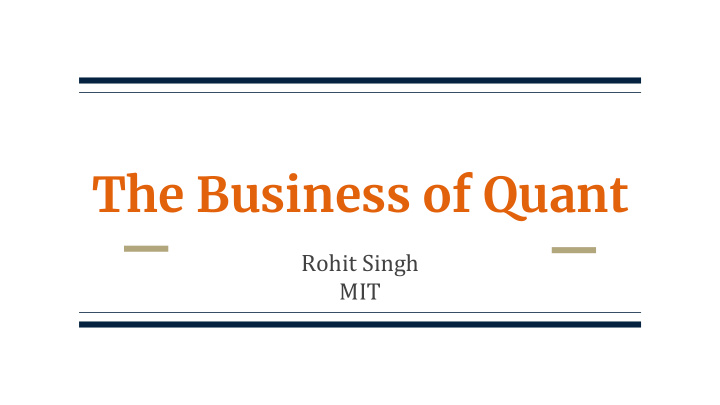



The Business of Quant Rohit Singh MIT
Administrivia ● Please sign in ● Slides available at: http://people.csail.mit.edu/rsingh ● Please send feedback: Rohit Singh (rsingh@mit.edu)
Guest Speaker: David Mittelbusher
Recapping last week ● Popular strategy ideas: ○ CTAs ○ Statistical Arbitrage ○ High frequency trading ■ Payment for order flow & Robinhood
Building Quant Businesses
Asset Management ● Basic model: “I’ll try to grow your money; You pay me a fee” ● Four ways of charging fees: ○ Per-transaction (brokers and some wealth management advisors) ○ Fixed (for small accounts, typically) ○ Percentage of assets ○ Percentage of assets + Percentage of gains Mutual Funds HF + PE + VC ● ● Need to be open to all Accredited investors (>$200K income or >$1M assets) ● ● Minimal Leverage Reporting requirements in some cases ● ● Liquid instruments Fairly loose rules ● ● Daily Pricing Charge what the market will bear ● No performance fee!
HF vs VC vs PE Hedge Funds vs Private Equity / Venture Capital ● Public markets Private markets ● Management fee in both ● Performance fee Carry ● Capital on 1st day Capital Calls ● Mark to market Mark to ??? ● Liquid Illiquid http://www.sigmavaluation.com/hedge-pe-funds/
The Hedge Fund Business AUM Gross Management Performance Net HF HF Costs HF Profits Returns Fee Fee Return Revenue $1M 10% 2% 20% 6.4% $36K $0.4M -$364K $25M 10% 2% 20% 6.4% $0.9M $0.4M $0.5M $100M 10% 1.5% 15% 7.2% $2.8M $2.5M $0.3M $100M 8% 1.5% 15% 5.5% $2.4M $4M -$1.6M $1000M 10% 1% 10% 8.1% $19M $7M $12M Addendums: ● High Watermark ● Share Classes (Discounts to early investors or Fund-of-funds) ● Separately Managed Accounts
Types of Quant Funds Split by Bravery, Brawn or Brains ● Very few large firms based exclusively on Brains ● Brains edges more commonly seen in small firms ● Brains edges often “grow up” into a Brawn+Brains or Bravery+Brains edge Business Size (except proprietary trading firms): ● Single-theme funds: < $1B ● Smaller multi-strat funds: $1-5B ● Mega firms: $5-$50B ● > $100B: AQR, Bridgewater
Bravery-based Business Models Strategies Involved Factor Investing, CTA, Risk Parity Performance Low sharpe, Moderate returns, Mildly correlated Capacity Huge >50B Operating Cost Low Customer Acquisition Large potential markets: pension funds, SWFs, retail Potential for customer churn due to risk involved Competitive Edge Sales, Branding (e.g. thought leadership), Pricing
Bravery-based Business Models
Example: The Rise & Fall of Bill Miller pre-2007 https://fosterwealth.com/bill-miller-and-why-you-cant-trust-stock-picking
Brawn-based Business Models #1 Strategies Involved HFT Performance High Sharpe, Great returns, Uncorrelated Capacity Low (<1-5B) Operating Cost Very High Customer Acquisition Very easy once the model is proven Strong pricing power (but mostly, prop money) Competitive Edge Large scale to absorb high fixed costs Spend on technology : speed and connectivity (technology) Footprint and deal-making (e.g. Virtu)
Brawn-based Business Models #1
Brawn-based Business Models #2 Strategies Involved Multi-strat: aggregator of various strategy types Performance Moderate Sharpe, Moderate Returns, Possibly Correlated Capacity Huge (>50B?) Operating Cost Moderate Customer Acquisition Significant sales effort needed Look for customers who can’t access individual pieces Pricing power under pressure Competitive Edge Talent arbitrage : be good at picking quants (and firing them) Branding: be seen as a good talent-spotter Scale : Netting benefits, Alpha capture
Brawn-based Business Models #2
Brawn-based Business Models #3 Strategies Involved Predicting performance + Statistical arbitrage + Factors Performance Good Sharpe, Good returns, Less correlated than #2 Capacity Medium to High (5-30B?) Operating Cost High Customer Acquisition Sales is much easier than Bravery-based models Stronger pricing power than Bravery-based models Competitive Edge Invest in technology and infrastructure to: - Identify new data sources continuously - Generate alpha from them and integrate into the system Large scale, to absorb data costs
Brawn-based Business Models #3
Brains-based Business Models Proprietary capital ● Limited scalability. Otherwise, transition to a Brawn+Brains or Bravery+Brains model ● Under the radar, to safeguard their IP and competitive edge ● Often occupy a niche (e.g. Jane Street) Startup, Sub-$1B funds ● Difficult space of the market: high costs ● Have to do a lot of sales to convince customers of value
Building a Quant Career
Careers in Quant Coding ● Speed, not scale Additional Axis: Sales ● Internal customers Trading Data Science ● ● In addition to ML, ideas Domain knowledge ● from traditional Bet sizing and risk Statistics, Physics, Math management
What Kind of Quant Career Might Suit You? Depending on what you like... ● Building big systems or fast systems? ● Kaggle type ML or more research-oriented ML? ● Competing with others or collaborating with them? ● Ok making quick, possibly incorrect decisions or want to take your time? ...you can find a role that suits you best HFT Software Dev; Bank trading algo designer; Gray box trader Quant researcher; Portfolio manager; Quant fund sales
Quant vs. Tech Careers ● Project scope and duration ● Front-end vs Back-end work ● Specialist vs generalist work ● Team sizes ● Stress & work-life balance ● Compensation
Quant Careers outside Quant Funds Service Providers: fund admin, risk mgmt Pension Funds, Prime Brokers Quant Fund SWFs, & Allocators Investment Banks Alternative Data FinTech, VC, PE Provider
What if you want to just trade your personal portfolio via quant algos ? ● Rule #1: Think about your taxes and transaction costs ○ Feasible quant strategies will typically look like slow-moving asset allocation ideas ● Rule #2: Figure out your edge ● Rule #3: Manage risk. Be skeptical of your signal initially. ● Rule #4: Do what is consistent with your psychology
Further Reading
Thank You! Please send feedback: rsingh@mit.edu

Recommend
More recommend